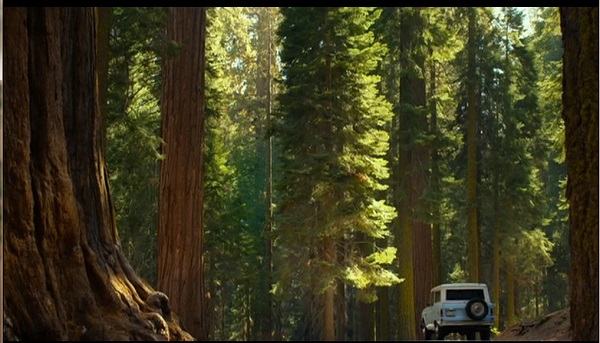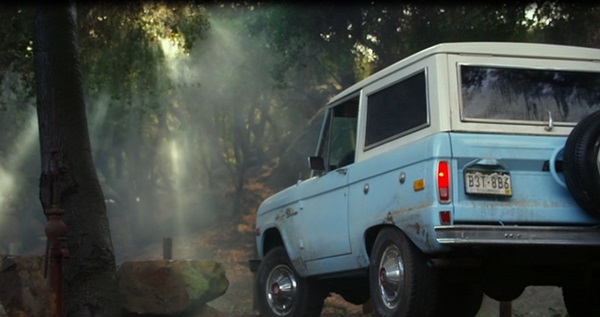Atlas Shrugged Part III: Who Is John Galt?
After plucking her out of the burning wreckage of her crashed plane (an event that, like in the books, only causes minor bruising and slight sleepiness), bargain-basement Matthew McConaughey takes Dagny on a tour of the capitalists’ secret utopia. Remember, Galt’s Gulch is high in the alpine wilderness of the Rocky Mountains, so it makes total sense that they drive through towering groves of these:

These must be the famous majestic redwoods of Colorado. Presumably, they’re right next to the orange groves. I’m surprised they didn’t show palm trees while they were at it.
This not-even-bothering-about-the-details attitude pervades the third film. Time and again, the filmmakers can’t be bothered to do more than sloppily gesture in the direction of accuracy. Whether it’s small things like trees that are wildly out of place and far from their natural habitat, or larger things like stock footage standing in for plot or characters whose age and ethnicity veer all over the map, the movie’s rampant flaws keep jarring against the viewer’s suspension of disbelief. It’s like someone elbowing you in the side every few minutes. In the words of MST3K, they just didn’t care.
Here’s another example. You can see in a couple of shots that John Galt’s car has license plates:

Why does he have these? Is there a DMV in Galt’s Gulch? They just didn’t care.
There’s also this whopper of an oversight. You’d think, given the filmmakers’ obvious devotion to Ayn Rand, that they’d at least be well-versed in the book they’re adapting. But apparently not, because there’s a line of dialogue where John Galt uses the dreaded word “give” – which, according to the text, is the one word that’s forbidden to be uttered in the valley. That’s supposed to be the only law they have:
Why don’t all the other capitalists react to this the same way the Knights Who Say Ni! scream and flinch from the word “it”?
The movie isn’t just sloppy in these incidentals, but in its core arguments that socialist policies and business regulations are the cause of every bad thing in the world. One example is the scene where Dr. Hendricks examines Dagny to see if she has any injuries from her plane crash. In the book, he brings “a portable X-ray machine”, this being the height of high-tech at the time Atlas Shrugged was written. That wouldn’t sound so cutting-edge today, so in the movie, he whips out a medical gadget that’s basically a Star Trek tricorder:
Leave aside, again, that the filmmakers couldn’t take the time to build a a prop that looks suitably futuristic. Instead, they just have him wave around what looks like an iPad. (Internal body scans? There’s an app for that.)
More absurd than that is his assertion that a device like this is easy to create when there’s no “red tape”. What red tape is he referring to? Is there a government regulation that’s holding back the tricorder? What law stops the invention of revolutionary new medical devices, as opposed to regulating how they’re marketed and sold? (Unless it was the law against coerced human experimentation? Uh-oh, someone had better check Dr. Hendricks’ basement.)
Like Michele Bachmann claiming that the free market could cure Alzheimer’s in ten years if left to itself, the filmmakers are asserting that ending all regulation would somehow make it possible for people to think up inventions they wouldn’t be able to think of otherwise. In their one-reason worldview, the problem isn’t that technological progress is hard and intrinsically slow, but that The Evil Government is the sole source of anything and everything that upsets or frustrates us.
Last but not least, there’s the scene after Dagny returns to New York, where she discovers John Galt is working as a manual laborer for her company. The sight of his greasy coveralls drives her into a whirlwind of lust, and they have sex in a disused railroad tunnel. In the movie’s faux-artistic depiction, it’s just a minute of Lifetime-original-movie music accompanied by disembodied body parts shown in silhouette, such that it’s hard to be exactly sure who’s doing what to whom. But the absolute best thing is that the scene ends with – I swear I’m not making this up – a railroad worker guiding a train into a tunnel:
The inherent hilarity of this juxtaposition robs the scene of all the emotional gravity it’s supposed to have. What should be the dramatic, poignant consummation of Dagny and John Galt’s love turns into farce. Did they not notice? Or was it that they just didn’t care?
Other posts in this series: